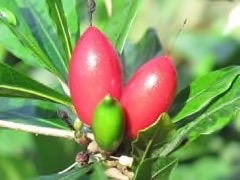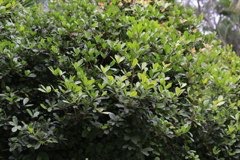 |
|
MiracleFruitFarm wikimedia.org |
 |
| Zhangzhugang wikimedia.org |
Translate this page:
Summary
Miracle Berry, Synsepalum dulciferum, is an evergreen shrub in Western and Central Tropical Africa that grows up to 6 m in height. This tree has no medicinal value but is cultivated for food. The fruits are edible and can be consumed raw. Fruits are oblong berries with sweet and fleshy pulp. It contains miraculin, a glycoprotein, which makes bitter, sour, and salty food taste sweet. Twigs are used as chew sticks to clean the teeth. The wood is used for fuel.
Physical Characteristics

 Synsepalum dulciferum is an evergreen Shrub growing to 4 m (13ft) by 4 m (13ft) at a fast rate.
Synsepalum dulciferum is an evergreen Shrub growing to 4 m (13ft) by 4 m (13ft) at a fast rate.
See above for USDA hardiness. It is hardy to UK zone 10.
Suitable for: light (sandy), medium (loamy) and heavy (clay) soils and prefers well-drained soil. Suitable pH: mildly acid and neutral soils and can grow in very acid soils.
It cannot grow in the shade. It prefers moist or wet soil.
UK Hardiness Map
US Hardiness Map
Synonyms
Bakeriella dulcifica (Schumach. & Thonn.) Dubard Bumelia dulcifica Schumach. & Thonn. Pouteria dulci
Plant Habitats
Edible Uses
Edible Parts: Fruit
Edible Uses: Condiment Sweetener
Fruit - raw[416 ]. The thin-skinned fruit has a sweet, fleshy pulp[416 ]. The ripe fruit, although not itself that sweet to taste, has the ability to modify the taste receptors in the mouth, causing foods to taste sweeter[46 , 301 ]. The effect lasts for up to an hour after consuming the fruit and will, for example, make lemons, vinegar and other acid foods taste sweet. Sweet foods, such as ice cream, will taste cloyingly sweet[301 ]. The oblong fruit is about 20mm x 10mm[200 ]. The berries contain miraculin which is the active principle that makes bitter, sour and salty food taste sweet by affecting the taste-buds[317 ]. In this manner used for 'sweetening' palm wine, sour fruits and other drinks or food. Additionally a glucoprotein is present that depresses the appetite[317 ].
References More on Edible Uses
Medicinal Uses
Plants For A Future can not take any responsibility for any adverse effects from the use of plants. Always seek advice from a professional before using a plant medicinally.
None known
References More on Medicinal Uses
The Bookshop: Edible Plant Books
Our Latest books on Perennial Plants For Food Forests and Permaculture Gardens in paperback or digital formats.

Edible Tropical Plants
Food Forest Plants for Hotter Conditions: 250+ Plants For Tropical Food Forests & Permaculture Gardens.
More

Edible Temperate Plants
Plants for Your Food Forest: 500 Plants for Temperate Food Forests & Permaculture Gardens.
More

More Books
PFAF have eight books available in paperback and digital formats. Browse the shop for more information.
Shop Now
Other Uses
Fuel Teeth
Other Uses: The twigs are used as chew sticks to clean the teeth[332 ]. The wood is used for fuel[332 ].
Special Uses
Food Forest
References More on Other Uses
Cultivation details
A plant of the hot, wet, tropical lowlands[335 ]. Plants are intolerant of frost[335 ]. Prefers a humus-rich acid soil[335 ]. Grows well in light shade[335 ]. Seedling plants can commence fruiting when about 4 - 5 years old[335 ]. Plants can flower several times a year[335 ].
References Carbon Farming Information and Carbon Sequestration Information
Temperature Converter
Type a value in the Celsius field to convert the value to Fahrenheit:
Fahrenheit:
The PFAF Bookshop
Plants For A Future have a number of books available in paperback and digital form. Book titles include Edible Plants, Edible Perennials, Edible Trees,Edible Shrubs, Woodland Gardening, and Temperate Food Forest Plants. Our new book is Food Forest Plants For Hotter Conditions (Tropical and Sub-Tropical).
Shop Now
Plant Propagation
Seed -
Other Names
If available other names are mentioned here
Miracle fruit, Miracle berry, Miraculous berry, Sweet berry in West Africa, Agbayun, Taami, Asaa, and Ledidi.
Native Range
AFRICA: Western and Central Tropical Africa.
Weed Potential
Right plant wrong place. We are currently updating this section.
Please note that a plant may be invasive in one area but may not in your area so it's worth checking.
Conservation Status
IUCN Red List of Threatened Plants Status : This taxon has not yet been assessed

Growth: S = slow M = medium F = fast. Soil: L = light (sandy) M = medium H = heavy (clay). pH: A = acid N = neutral B = basic (alkaline). Shade: F = full shade S = semi-shade N = no shade. Moisture: D = dry M = Moist We = wet Wa = water.
Now available:
Food Forest Plants for Mediterranean Conditions
350+ Perennial Plants For Mediterranean and Drier Food Forests and Permaculture Gardens.
[Paperback and eBook]
This is the third in Plants For A Future's series of plant guides for food forests tailored to
specific climate zones. Following volumes on temperate and tropical ecosystems, this book focuses
on species suited to Mediterranean conditions—regions with hot, dry summers and cool, wet winters,
often facing the added challenge of climate change.
Read More
Expert comment
Author
Schumach. & Thonn.) Daniell.
Botanical References
Links / References
For a list of references used on this page please go here
A special thanks to Ken Fern for some of the information used on this page.
Readers comment
| Add a comment |
|
If you have important information about this plant that may help other users please add a comment or link below. Only comments or links that are felt to be directly relevant to a plant will be included. If you think a comment/link or information contained on this page is inaccurate or misleading we would welcome your feedback at [email protected]. If you have questions about a plant please use the Forum on this website as we do not have the resources to answer questions ourselves.
* Please note: the comments by website users are not necessarily those held by PFAF and may give misleading or inaccurate information.
To leave a comment please Register or login here All comments need to be approved so will not appear immediately.
|
Subject : Synsepalum dulciferum
|
|
|
|